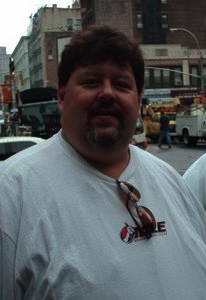My favorite aspect of my Journalism class is that we get the opportunity to meet and interview interesting individuals from the Pennsylvania area. Last week, we interviewed William “Wild Bill” Myers, a professional eater who is ranked 35 out of 50 in the MLE (Major League Eaters).
I’m going to be honest; I’m not the biggest fan of professional speed eating. Personally, the sight of people forcing vast quantities of food down their throats as fast as possible is not appealing to me. What ever happened to savoring every bite of your food for its delicious flavor? However, I will say that I learned a great deal about the sport of professional eating and gained a newfound respect for the eaters involved. Let’s just say, it’s not as easy as it looks.

"Wild Bill" Myers
Source
Myers, 47, has been involved in professional eating for six years and has competed in over 80 food contests. He first got involved in speed eating after seeing a food competition on TV. Myers told our class that after watching he thought, “I can do that.” His first competition was Nathan’s Hot Dog Eating Contest in May 2006. Myers explained that at the contest he told reporters he would eat 20 hot dogs when in reality, he finished 11. As I said, it’s much harder than it looks.
There are many techniques that contestants use during eating competitions. Some competitors will wear headphones to tune out the voices of the commentators and their competition. Sometimes contestants are permitted to dunk food in water to create more space inside of their stomachs.
On the morning of a contest Myers likes to eat a light breakfast and stays hydrated throughout the day. He said the strategy to eating quickly is “bite, swallow, repeat.” Most eating competition time frames vary from 6-12 minutes. Once Myers finished 16 hot dogs in 10 minutes!
During the interview, Myers cleared up some commonly held misconceptions regarding speed eating. For example, I was unaware that there are strict rules forbidding at-home training because of health risk factors. Some professional eaters perform water training, which is when someone consumes one or two gallons of water and regurgitates it to stretch their stomach. Myers argued that this damages human’s electrolytes. Also, if a contestant throws up during a competition they are immediately disqualified. “I don’t eat to the point where I feel physically sick,” he said.

Joey Chestnut
Source
Many of my classmates and I were curious as to why the most successful professional eaters are typically small and fit women (Sonya Thomas) or athletic men (Joey Chestnut). Myers explained that people who are overweight have a layer of fat lining their waistline that prohibits their abdomen from expanding. Thinner competitors do not have this “belt of fat” and are able to stretch their stomachs further to consume more food.
I respect that Myers is a part of professional eating for the social and travel aspects of competitions. I also admire his success and realize that I would never stand a chance against him in a competition and I definitely understand what makes professional eating as popular as it is today. Still, I can’t say that I’m going to be taping food contests on my DVR anytime soon.
Below is a video that displays the rivalry between two of the greatest professional eaters, Joey Chestnut and Takeru Kobayashi.


